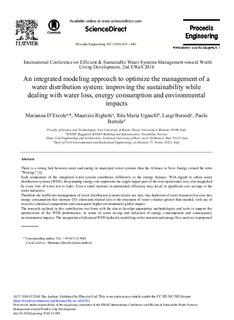| dc.contributor.author | D'Ercole, Marianna | |
| dc.contributor.author | Righetti, Maurizio | |
| dc.contributor.author | Ugarelli, Rita Maria | |
| dc.contributor.author | Berardi, Luigi | |
| dc.contributor.author | Bertola, Paolo | |
| dc.date.accessioned | 2016-11-29T13:46:08Z | |
| dc.date.accessioned | 2016-12-07T15:27:58Z | |
| dc.date.available | 2016-11-29T13:46:08Z | |
| dc.date.available | 2016-12-07T15:27:58Z | |
| dc.date.issued | 2016 | |
| dc.identifier.issn | 1877-7058 | |
| dc.identifier.uri | http://hdl.handle.net/11250/2424566 | |
| dc.description.abstract | There is a strong link between water and energy in municipal water systems then the Alliance to Save Energy coined the term "Watergy" [1].
Each component of the integrated water system contributes differently to the energy balance. With regard to urban water distribution systems (WDS), the pumping energy cost represents the single largest part of the total operational cost, also magnified by every litre of water lost to leaks. Even a small increase in operational efficiency may result in significant cost savings to the water industries.
Therefore the inefficient management of water distribution systems results not only into depletion of water resources but also
into energy consumption that increase CO2 emissions related also to the treatment of water volumes greater than needed, with use of excessive chemical components and consequent higher environmental global impact. The research outlined in this contribution was born with the aim to develop appropriate methodologies and tools to support the optimization of the WDS performance, in terms of water saving and reduction of energy consumptions and consequently environmental impacts. The integration of advanced WDS hydraulic modelling with a material and energy flow analysis is proposed herein, where the output of the hydraulic simulations permits to get more accurate input for a metabolic analysis of the system
Next phases of this research will test the integrated model under different scenarios, aimed at quantifying the environmental impact of different WDS management solutions by means of selected indicators | nb_NO |
| dc.language.iso | eng | nb_NO |
| dc.publisher | ScienceDirect | nb_NO |
| dc.subject | Water distribution system | nb_NO |
| dc.subject | Metabolic analysis | nb_NO |
| dc.subject | Energy consumption | nb_NO |
| dc.subject | Leakages | nb_NO |
| dc.subject | Environmental impacts | nb_NO |
| dc.title | An integrated modeling approach to optimize the management of awater distribution system: improving the sustainability whiledealing with water loss, energy consumption and environmentalimpacts | nb_NO |
| dc.type | Journal article | nb_NO |
| dc.type | Peer reviewed | nb_NO |
| dc.date.updated | 2016-11-29T13:46:08Z | |
| dc.rights.holder | © 2016 The Authors. Published by Elsevier Ltd. This is an open access article under the CC BY-NC-ND license (http://creativecommons.org/licenses/by-nc-nd/4.0/). | nb_NO |
| dc.subject.nsi | VDP::Teknologi: 500 | nb_NO |
| dc.subject.nsi | VDP::Technology: 500 | nb_NO |
| dc.source.pagenumber | 433-440 | nb_NO |
| dc.source.volume | 162 | nb_NO |
| dc.source.journal | Procedia Engineering | nb_NO |
| dc.identifier.doi | 10.1016/j.proeng.2016.11.085 | |
| dc.identifier.cristin | 1405796 | |
| dc.subject.keyword | Energibruk / Energy use | |
| dc.subject.keyword | Lekkasjer / Leakages | |
| dc.subject.keyword | Metabolisk analyse / Metabolic analysis | |
| dc.subject.keyword | Vannledningsnett / Water distribtution system | |
